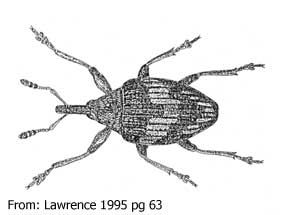Major Group: Insecta
Order: Coleoptera
Family: Nanophyidae (formerly Brentidae)
Genus: Austronanodes (formerly Nanophyes)
In Australia, this family is represented by a single genus, Austronanodes. |
Descriptive Features:
Adults
head with long, narrow rostrum
antennae geniculate with vey long scape
antennal club long and distinctly segmented
antennal insertions concealed from above by projections of frons
labrum not visible
maxillae and labium reduced
ventral portion of the notum, (hypomeron) on each side joined directly to the sternum by notosternal suture
pleuron reduced and concealed
abdomen with more than 3 ventrites
intercoxal process on ventrite 1 broadly rounded
size:
Larvae
labial palps 1-segmented
frontal arms reaching mandibular articulations
body slender, subcylindrical, curved, slightly sclerotised
legs absent
tergum 3 with 2 transverse plicae
size: |

|
Nanophyes larva |
|
|

|
Nanophyes adult |
|
Taxonomic Checklist: Species
Austronanodes alleni Lea (larva unknown)
Austronanodes marus Pascoe (larva unknown)
Austronanodes nigrovarius Lea
Austronanodes pallidicornis Lea (larva unknown)
Austronanodes v-notatus Lea (larva unknown) |
|
Distribution: Qld, NSW, Vic, SA, NT
Sensitivity Rating: SIGNAL grade 3 (as Brentidae)
Functional Feeding Group: shredders |

|
Tuppal Creek near Deniliquin, NSW |
|
|
Ecology: Commonly known as 'potato weevils' or 'timber weevils', records of, and information on Nanophyidae in Australian freshwater habitats are not common.
Instream habitat: In the northern hemisphere, semi-aquatic Nanophyidae species are found in riparian and littoral areas, where the adults live under dead bark. In Australia, Austronanodes has been found in macrophyte beds in still water.
Feeding ecology: In the northern hemisphere, nanophyid adults are shredders of organic matter, usually wood. They can survive dry periods by also feeding on the sap of flowering plants. In Australia, Austronanodes has been recorded feeding on stems of the aquatic macrophyte Ludwigia
Habit:
Life history: Terrestrial North American adults lay eggs in dying or recently fallen hardwoods, then after hatching larvae burrow deep into the logs. It is possible that Australian semi-aquatic species utilise riparian woody debris in a similar manner. The larval period of northern species may last a year and adults can live for more than one breeding season.
|
| |
Information Sources: Zimmerman 1993, 1994, Lawrence 1992, Lawrence & Britton 1991, 1994, Ulyshen et al. 2004, Jach 1998, Sforzi & Bartolozzi 2004
Key to Species: Zimmerman 1993 (adults) |
|
|
|